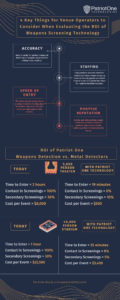As stadiums, theaters and other entertainment venues begin to open back up this spring and summer, guests are eager to enjoy those experiences again. But in a world now characterized by contactless experiences, patrons aren’t looking forward to long security lines and excessive contact from slow weapons-screening processes. Heightened awareness of the risk of weapons has many venues reconsidering their security approach and ensuring that they adhere to standards such as the DHS Safety Act. Further, most venues today are now required to have weapons screening technology and processes in place, and for those that aren’t, providing customers with a safe environment is now a competitive necessity.
To date, the most common form of weapons screening is some combination of metal detectors and wands, with physical “pocket emptying” of metal. Then there’s the secondary screenings: divesting tables for bags and pat downs. This approach is inherently “high contact” and requires multiple staff members at every entry point to process incoming patrons.
From a business perspective, this lengthy process takes a bite out of the bottom line of every event through the cost of screening infrastructure and manpower, the opportunity cost of delaying entry into the venue (which can impact concessions sales), and the damage to the overall customer experience. From a patrons’ perspective, the experience is poor and the delays frustratingly unnecessary.
However, there is significant return on investment (ROI) to be had with improved admission processes, most notably through the adoption of a non-intrusive threat and weapon detection solution. The ROI can look different depending on the type of venue – for example, a 5,000-person Broadway theater has a different security and cost model than a 40,000-person stadium, with different points of entry/exit, crowd flows, layout and more. What they both share in common, though, is the need to “make a great first impression,” while maintaining high levels of safety.
This can be accomplished with a non-intrusive system that enables people to flow freely into the venue without having to stop, even if the person in front of them is caught carrying a weapon. When considering this kind of next-generation screening technology, there are four key factors to consider for maximizing ROI vs. the traditional approach: accuracy, staffing, speed of entry and reputation impact. These must be balanced to meet the unique requirements of each location:
Accuracy
False positives are an ROI killer, and false negatives will let weapons into the venue. Accuracy, then, is the most important factor to consider in weapons detection technology. All screening systems balance detection rate against alert rate − however, these numbers do not have to be mutually exclusive as is the case with walk-through metal detectors, where it is not possible to increase detection sensitivity without also increasing false positives. With modern non-intrusive systems, it is possible to have a highly sensitive detection rate and a low alert rate, if the system has sufficient accuracy built into it. These parameters must be balanced with the required security certifications, and the venue security operations strategy.
Staffing
The number of staff required to perform screening is the highest cost consideration. Metal detectors require multiple guards per device – one to monitor people walking through, another looking through bags, and others for a pat-down or other secondary screening. A non-intrusive, accurate weapons-detection system requires significantly fewer guards, or in some applications with the correct technology, no staff monitoring the entrances. Detection systems that can discern between metal and weapons allow the bulk of patrons to enter freely, and require a much smaller staff to address alerts.
Speed of Entry
By eliminating the requirement to screen all patrons and secondarily screen a large number of those, venue operators can typically achieve a throughput that is six to eight times faster than traditional walk-through metal-detection systems. For a 40,000-person stadium, this could be the difference between patrons standing in line for an hour or more, versus filling the stadium within minutes. Further, as long as people are waiting in line, it means they can’t spend money inside on concessions or merchandise – equating to hundreds of thousands of dollars in lost revenue in large venues. Check out our blog post for more on this hidden metal detector tax here.
Reputation Impact
Quickly and safely getting people in the doors will create a positive reputation and brand experience for the venue – particularly when competing venues are using the old and inefficient metal detector approach. In today’s business, and particularly in the entertainment world, the patron experience is key. Sports teams, casinos, live entertainment venues, etc. are not selling a ticket – they are selling an experience. That experience starts before the event begins: on the approach, during entry and within the first steps into the venue.
The traditional approach of divesting people of metal, making them walk through a detector, searching their bags and possibly patting them down during further screening is diametrically opposed to the ideal experience people want and also a risk to the millions of dollars invested in creating the overall experience for them. Imagine the Kentucky Derby: 150,000 patrons dressed in their finery, hats and fashion, waiting unnecessarily while the line goes through hundreds of pat-downs. You can just picture the Mint Juleps melting in the sun!
Showing an investment in the most modern and customer-friendly safety technology sends a positive message to all attendees. It provides tangible proof that the venue cares about their safety and their overall experience. Most of all, it eliminates a significant barrier between patrons and a superior venue experience.

